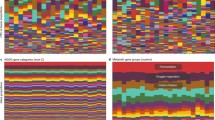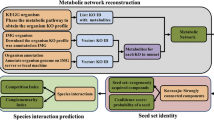Abstract
With the omics tool, the challenges in understanding the microbial community functions are becoming more intriguing. It is the environment created scenario, which demands alignment of the different members of the community for the desired output leading to common condition for their survival. The resultant community pathways provide a broad umbrella of metabolic options giving the desired plasticity, which plays decision making role in the adaptation process. The initial step in community characterization must involve the discovery of key and core member of the community and monitoring the fluctuations in functional abundance over the space and time. The concept of entropy and metabolic fluxes must reflect the inner metabolic machinery of the taxon selection and route of functional operation in a community. The segregation of member based on their functional role and hierarchical level in the community must be an essential step to be followed by interaction mapping and measurement of metabolic fluxes to derive the flow of metabolites within the community. This conceptual framework and integrated omics tools with supported statistical modeling algorithm can help in bringing out finer details in the process of community functional adaptation in any given scenario.

Similar content being viewed by others
References
Talkal R, Tikariha H, Purohit H (2018) An approach to in silico dissection of bacterial intelligence through selective genomic tools. Indian J Microbiol 58:278–286. https://doi.org/10.1007/s12088-018-0726-0
Puranik S, Purohit HJ (2014) Dependency of cellular decision making in physiology and influence of preceding growth conditions. Appl Biochem Biotechnol 174:1982–1997. https://doi.org/10.1007/s12010-014-1167-9
Xie J, He Z, Liu X et al (2011) GeoChip-based analysis of the functional gene diversity and metabolic potential of microbial communities in acid mine drainage. Appl Environ Microbiol 77:991–999. https://doi.org/10.1128/AEM.01798-10
Bai S, Li J, He Z et al (2013) GeoChip-based analysis of the functional gene diversity and metabolic potential of soil microbial communities of mangroves. Appl Microbiol Biotechnol. https://doi.org/10.1007/s00253-012-4496-z
Lu Z, He Z, Parisi VA et al (2012) GeoChip-based analysis of microbial functional gene diversity in a landfill leachate-contaminated aquifer. Environ Sci Technol 46:5824–5833. https://doi.org/10.1021/es300478j
Purohit HJ, Kapley A, Khardenavis A, Qureshi A, Dafale NA (2016) Insights in waste management bioprocesses using genomic tools. In: Sariaslani S, Gadd GM (eds) Advances in applied microbiology, vol 97. Elsevier Ltd, Amsterdam, pp 121–170
Embree M, Liu JK, Al-Bassam MM, Zengler K (2015) Networks of energetic and metabolic interactions define dynamics in microbial communities. Proc Natl Acad Sci 112:15450–15455. https://doi.org/10.1073/pnas.1506034112
Gupta V, Gupta N, Capalash N, Sharma P (2017) Bio-prospecting bacterial diversity of hot springs in northern himalayan region of India for Laccases. Indian J Microbiol 57:285–291. https://doi.org/10.1007/s12088-017-0656-2
Sung J, Kim S, Cabatbat JJT et al (2017) Global metabolic interaction network of the human gut microbiota for context-specific community-scale analysis. Nat Commun 8:1–12. https://doi.org/10.1038/ncomms15393
Tikariha H, Khardenavis AA, Purohit HJ (2018) Dissolved oxygen-mediated enrichment of quorum-sensing phenomenon in the bacterial community to combat oxidative stress. Arch Microbiol 200:1–9. https://doi.org/10.1007/s00203-018-1551-x
Vallino JJ (2010) Ecosystem biogeochemistry considered as a distributed metabolic network ordered by maximum entropy production. Philos Trans R Soc B Biol Sci 365:1417–1427. https://doi.org/10.1098/rstb.2009.0272
Hunting ER, Vijver MG, van der Geest HG et al (2015) Resource niche overlap promotes stability of bacterial community metabolism in experimental microcosms. Front Microbiol 6:1–7. https://doi.org/10.3389/fmicb.2015.00105
Hanson NW, Konwar KM, Hawley AK, Altman T, Karp PD, Hallam SJ (2014) Metabolic pathways for the whole community. BMC Genom 15:1–14. https://doi.org/10.1186/1471-2164-15-619
Gerber GK, Onderdonk AB, Bry L (2012) Inferring dynamic signatures of microbes in complex host ecosystems. PLoS Comput Biol 8:e1002624. https://doi.org/10.1371/journal.pcbi.1002624
Ribière C, Beugnot R, Parisot N et al (2016) Microbial environmental genomics (MEG). Microb environ genomics (MEG). Methods Mol Biol 1399:167–182. https://doi.org/10.1007/978-1-4939-3369-3
Goldford JE, Lu N, Bajić D et al (2018) Emergent simplicity in microbial community assembly. Science 361:469–474. https://doi.org/10.1126/science.aat1168
Trigo A, Valencia A, Cases I (2009) Systemic approaches to biodegradation. FEMS Microbiol Rev 33:98–108. https://doi.org/10.1111/j.1574-6976.2008.00143.x
Taillefumier T, Posfai A, Meir Y, Wingreen NS (2017) Microbial consortia at steady supply. Elife 6:1–65. https://doi.org/10.7554/elife.22644
Purohit HJ, Tikariha H, Kalia VC (2018) Future perspectives of computational biology: demanding shifts in analytical thinking to unfold biological complexities. In: Purohit HJ, Kalia VC, More RP (eds) Soft computing for biological systems. Springer Singapore, Singapore, pp 283–293
Acknowledgements
Hitesh Tikariha acknowledges the University Grants Commission for the Senior Research Fellowship. The author also acknowledges the support provided by CSIR-NEERI and KRC for plagiarism check (CSIR-NEERI/KRC/2019/MAY/EBGD/1).
Author information
Authors and Affiliations
Corresponding author
Ethics declarations
Conflict of interest
The authors declare that they have no conflict of interest.
Additional information
Publisher's Note
Springer Nature remains neutral with regard to jurisdictional claims in published maps and institutional affiliations.
Rights and permissions
About this article
Cite this article
Tikariha, H., Purohit, H.J. Different Dimensions in Microbial Community Adaptation and Function. Indian J Microbiol 59, 387–390 (2019). https://doi.org/10.1007/s12088-019-00813-1
Received:
Accepted:
Published:
Issue Date:
DOI: https://doi.org/10.1007/s12088-019-00813-1




